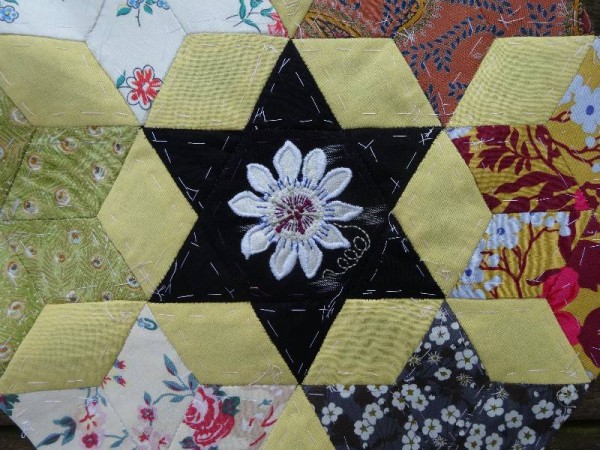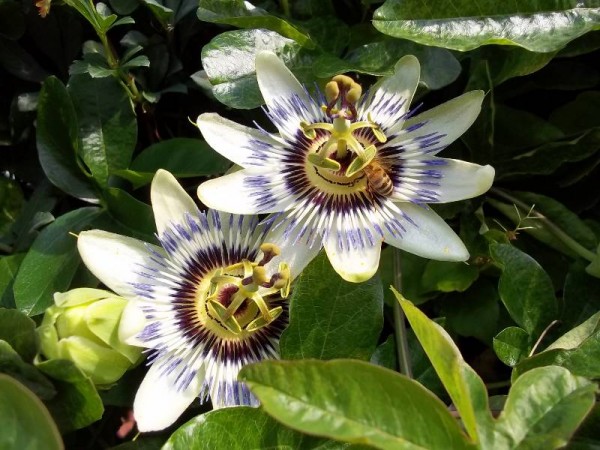
Ipsden Church, Oxon: patchwork altar frontal, detail of passionflower (hand embroidered by Mary Addison)
Over the last week I’ve managed to fit in embroidering another flower found in local gardens. Passionflowers always seem rather too beautiful to be true and I find embroidering them equally rewarding. Their name, an abbreviation of the Latin, Flos Passionalis, literally flower of suffering, is an appropriate flower to show as we approach the drama of Holy Week. Its association with Christ’s suffering goes back to the early Jesuits who came across the flower in the New World as colonistation of the Americas advanced. They were much taken with the structure of the flower and used it as a sort of aide memoire of the Passion as they attempted to convert the native peoples to Christianity. The 3 stigmas represent the 3 nails used to nail Christ to the cross, 5 stamens and anthers represent the 5 wounds, while the filaments of the corona stand for the crown of thorns. The 10 petals and sepals framing the more intricate features of the flower represent the 10 disciples who were there at the Crucifixion (Judas and Peter being absent). (I had a sudden panic when I realised I only had 10 petals having forgotten the clever shoehorning of the story to the realities of the plant – how fortunate I copied the original one I embroidered from nature.) Symbolism continues with the green parts of the plants: 3 flower bracts represent the Trinity, the 5-lobed leaves are the hands of Christ’s persecutors (in fact not all passionflowers have 5) , while the tendrils stand as a reminder of the cords that bound him.

Ipsden Church, Oxon: patchwork altar frontal, detail of hellebore (hand embroidered by Mary Addison)
P. incarnata, a passionflower with a longer and more frilly corona was probably the New World species originally encountered but this proved difficult to establish in European conditions, where the wetter winters were especially problematic. In Europe, P. caerulea flourishes and this is the variety I have based my embroidery on (the purple-red should be more of a mahogany-brown but it looked better with a bit more colour against the black background). P. caerulea carries the additional symbolism of its blue and white colouring standing for Heaven and purity respectively. I made a hanging for my son-in-law to celebrate ‘Life, liberty and the pursuit of happiness’ from the American Declaration of Independence and used passionflowers as decoration. I now have it in mind to do a more botanical hanging of the flowers themselves, possibly on black silk, but much as I’d love to get on with that now, it’ll have to take its place in the queue.


2 Comments
These are really beautiful embroidered flowers!! At the moment there is an absolutely magnificent carpet of bluebells in the wood at the Nat Trust’s Greys Court just north of Henley…well worth a visit!
Thanks, Kate. Haven’t been to Greys Court since the NT revamped the facilities – must go again.